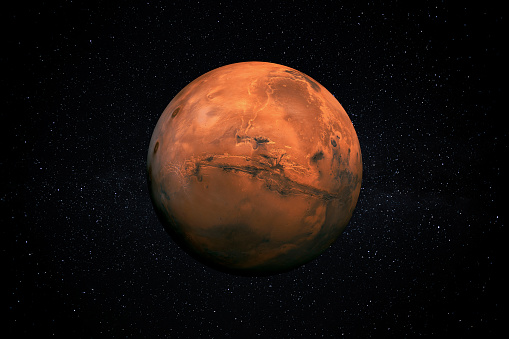
Mars is the fourth planet from the Sun and the second-smallest planet in the Solar System after Mercury.
In English, Mars carries a name of the Roman god of war, and is often referred to as the Red Planet because the iron oxide prevalent on its surface gives it a reddish appearance that is distinctive among the astronomical bodies visible to the naked eye.
Mars's average distance from the Sun is roughly 230 million km (143 million mi), and its orbital period is 687 (Earth) days. The solar day (or sol) on Mars is only slightly longer than an Earth day: 24 hours, 39 minutes, and 35.244 seconds. A Martian year is equal to 1.8809 Earth years, or 1 year, 320 days, and 18.2 hours.
The axial tilt of Mars is 25.19 degrees relative to its orbital plane, which is similar to the axial tilt of Earth. As a result, Mars has seasons like Earth, though on Mars they are nearly twice as long because its orbital period is that much longer. In the present day epoch, the orientation of the north pole of Mars is close to the star Deneb.
Mars has a relatively pronounced orbital eccentricity of about 0.09; of the seven other planets in the Solar System, only Mercury has a larger orbital eccentricity. It is known that in the past, Mars has had a much more circular orbit. At one point, 1.35 million Earth years ago, Mars had an eccentricity of roughly 0.002, much less than that of Earth today. Mars's cycle of eccentricity is 96,000 Earth years compared to Earth's cycle of 100,000 years. Mars has a much longer cycle of eccentricity, with a period of 2.2 million Earth years, and this overshadows the 96,000-year cycle in the eccentricity graphs. For the last 35,000 years, the orbit of Mars has been getting slightly more eccentric because of the gravitational effects of the other planets. The closest distance between Earth and Mars will continue to mildly decrease for the next 25,000 years.